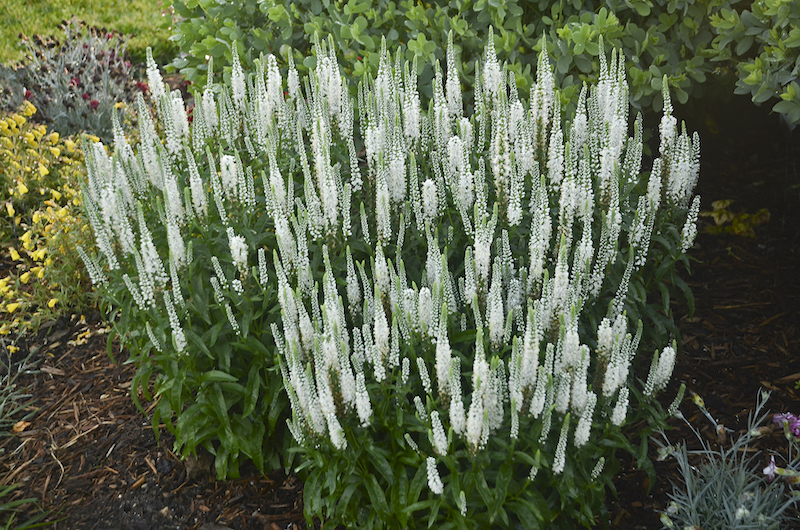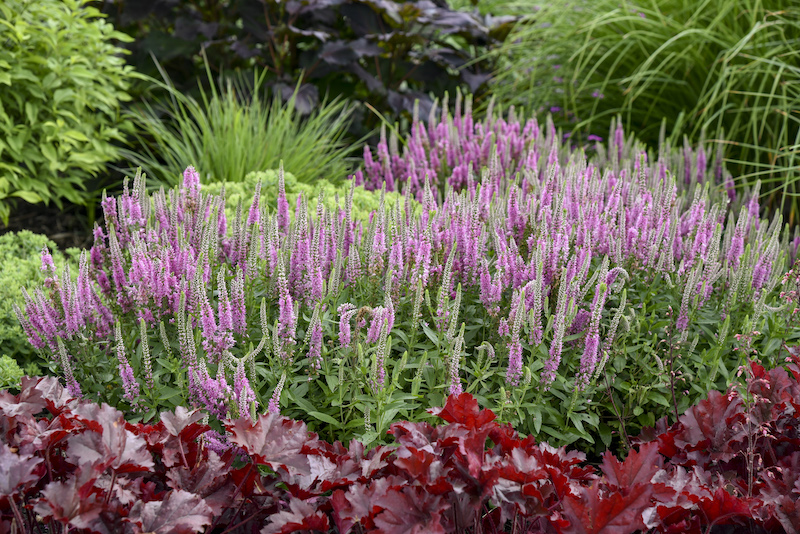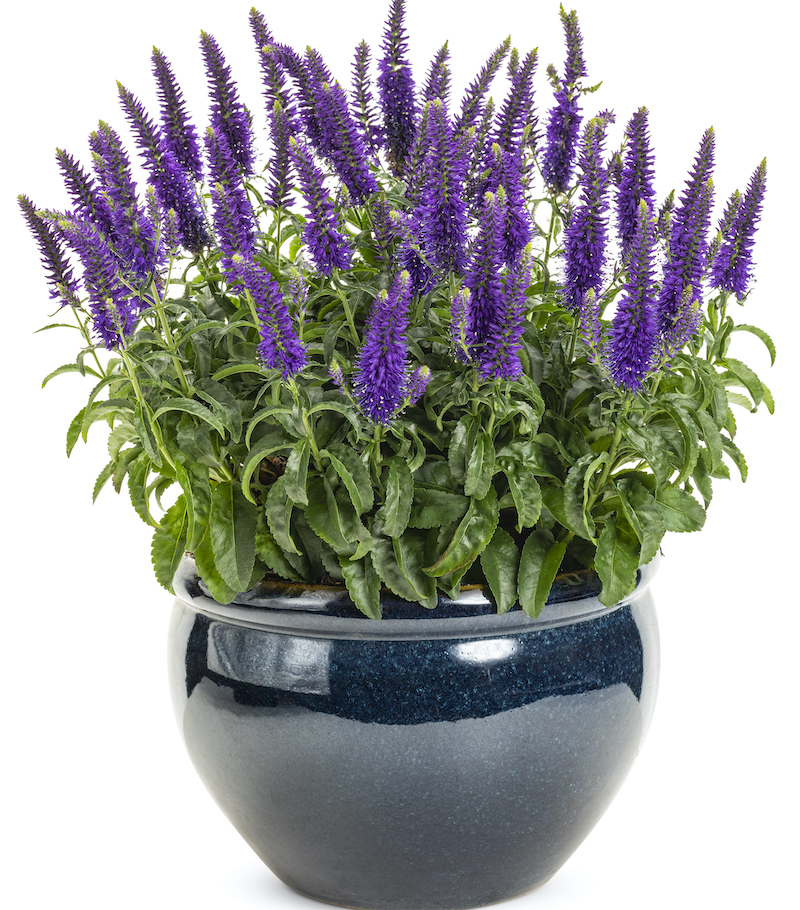Growing Speedwell
Speedwell is an herbaceous perennial that is cold hardy and blooms reliably for most of the summer months. In the warmer hardiness zones, Speedwell may be semi-evergreen, providing four-season interest in the garden. Veronica spicata is the scientific name of most ornamental cultivars grown. Veronica arvensis is the variety of speedwell that is considered a lawn weed: a mat forming, low grower that will quickly take over turf grasses.
The ornamental Speedwells are bushy, upright plants that naturally form clumps and have long flower spikes in all shades of blue, purple, pink and white. Speedwell will grow in a wide range of light levels and soil conditions and makes a perfect companion to most summer-blooming perennials. Native pollinating insects are highly attracted to the nectar as are hummingbirds. Songbirds will be attracted to the seedheads later in the fall.

Planting Speedwell
Speedwell appreciates full sun, but will tolerate partial shade. Full shade early or late in the day is acceptable as long as there is a period of direct sun for 6 or more hours. A neutral pH soil is the best for keeping Speedwell blooming and growing vigorously. Well-draining soil with low clay content is preferred. Heavy clay soils are tolerable as long as they can be made to drain well. The smaller varieties of Speedwell can be used as container plants either on their own or as part of a large mixed seasonal display.

Watering Speedwell
Speedwell is very drought tolerant after it has established and matured. Consistent watering when the plant is young is needed to produce a strong root system. Watering with soaker hoses and drip irrigation helps to direct water to the roots while keeping the leaves dry. MIldews and fungal diseases are common to Speedwell and are easily transmitted by water on the foliage.
Fertilizing Speedwell
Perennials do not often need regular fertilizing, and Speedwell is no exception. An annual application with a granular, slow-release, balanced formulation is generally enough to support vigorous growth all season long. Mulching with organic compost will also help to build the nutrients in the soil over time and slowly feed the plants. Container-grown Speedwell will need extra feeding on a regular basis throughout the summer. Using a diluted liquid fertilizer like seaweed or fish emulsion will help replace nutrients leached out of the potting soil through regular watering.
Pruning Speedwell
There are two types of pruning that Speedwell will need each year. First, regular deadheading of the spent flower spikes during the summer. This will help encourage continued blooming and color well into the fall. The second is cutting back dead plant material in the fall or early spring, depending on which zone you garden in. The colder zones (3-6) will see Speedwell die back to the ground after the first few frosts. This is the time to cut the plant back to within 2 inches of the ground and apply a mulch for the winter.
The warmer zones should let the plant die back naturally over the winter. Most of the foliage may remain semi-evergreen as long as the weather doesn't get too cold or snowy. The last round of flower spikes may also be left on the plant to form seed and feed the birds and other wildlife all winter.
Caring For Speedwell in Pots
Veronica spicata grows quite well in a container. The smaller varieties of Speedwell make lovely additions to large planters of mixed seasonal plants. Common companions for Speedwell are Petunias, Lantana, annual Verbena and sun-loving herbs such as Oregano and Thyme. Regular fertilizing during the summer months will be necessary to keep plants healthy and blooming. All fertilizing will need to be finished by August so that Speedwell can harden off and prepare for dormancy.

Winter Care for Speedwell
The hardy nature of Speedwell makes it a low-maintenance winter plant. The main thing to keep in mind is drainage. Poor drainage during the winter is the most common cause of demise for perennials and shrubs. Areas of the garden that seem well drained during the heat of the summer could be waterlogged bogs during the winter months in growing zones that receive heavy rain. If Speedwell is growing in the garden and seems to be too wet during the winter, it can be dug up and temporarily potted to spend the rest of the winter in a sheltered spot. Using mulches of finely shredded bark, leaves or compost will help to insulate growth crowns from the cold. Any mulch placed over crowns for the winter must be removed as early as possible in the spring to prevent rotting and improve air circulation.
Common Questions About Speedwell
Does Speedwell Need Sun Or Shade?
Speedwell appreciates full sun but will tolerate partial shade. Full shade early or late in the day is acceptable as long as there is a period of direct sun for 6 or more hours. A neutral pH soil is the best for keeping Speedwell blooming and growing vigorously.
Where Does Speedwell Grow Best?
Speedwell prefers to grow in full sun and well-draining soil. The soil can be anything from clay to sandy loam, as long as it drains well. The planting depth needs to be as deep as the pot it was grown in. Any soil that is shallow will not provide enough space for the root ball to develop and spread.
Will Speedwell Rebloom If Deadheaded?
Yes, Deadheading will prompt the plant to bloom again. The flower spikes on speedwell plants don't bloom all at once; instead, they appear in waves.
Is Speedwell Invasive?
Several species of speedwell are invasive and are considered weeds.
Is Speedwell An Annual Or Perennial?
Speedwell is an herbaceous perennial that goes completely dormant through the winter; it is an exceptionally hardy and low-maintenance plant.
Why Are Speedwell Leaves Turning Yellow, Brown, and/or Black?
Signs of underwatering for Speedwell are similar to signs of overwatering. Leaves that are drooping and/or turning brown at the tips can indicate watering problems. indications that it is very underwater.
What Is The Growth Rate of Speedwell?
Speedwell is a fast grower- grow from 2 to 18 inches tall, in full sun or light shade in any good garden soil
Is Speedwell Drought Tolerant?
Yes! Speedwell plants are deer resistant, drought tolerant, and attract hummingbirds and butterflies.
Have a question about Speedwell? Fill out the form below and we will try and get back to your question as soon as possible. We may even feature your question in this article to help other gardeners!
